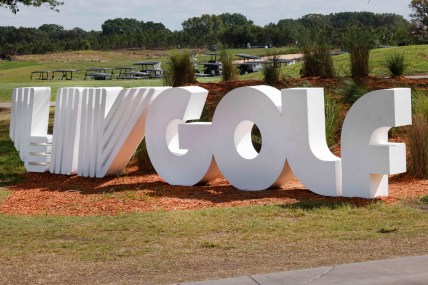On Thursday, the first round of the U.S. Open takes place for the third major of the year at Los Angeles Country Club with the highest paid golfers competing for the $10 million prize pool.
Located between Bel Air and Beverly Hills, the LA Country Club is going to test players throughout the property. Like any other U.S. Open course, strategically placed bunkers, difficult rough and multi-tiered putting surfaces are going to make it the toughest test in golf.
LA Country Club, which is seven miles away from Riviera Country Club, home to The Genesis Invitational that was won by Jon Rahm back in January, will also provide blind shots and barranca throughout the course to add even more difficulty.
The barrancas signify the landscape throughout the course with log bridges, sage brushes and some of the grass native to Southern California. LA Country Club ensured the landscape of the barrancas matched the erosion when rain does come to create possible waterways.
Utilizing the north course at LA Country Club, the field is going to see bentgrass putting greens as the fairway and rough are bermudagrass for the first time since 2005.
Although precipitation is not in the forecast, players need to figure out where to best place their shots on Monday, Tuesday and Wednesday to be in a situation to record birdies before Thursday’s first round.
Related: How all four golf majors are unique and provide tradition
Here is the course preview with the difficulty of each hole from toughest to easiest at LA Country Club for the 2023 U.S. Open.
1. Hole 16: 542 yards Par 4
This hole is the longest par 4 on the course at 542 yards. The 16th, which is the first of three challenging holes to conclude the round, has bunkers near the landing zone of the downhill tee shot.
Players have to ensure their approach shots lands on the green with a greenside bunker located in the front right portion before the putting surface. In order to try and possibly take off a shot, players will have to have a strong approach with a mid-iron. Having a front pin location will be a bonus.
2. Hole 2: 497 yards Par 4
It is vital that the players drive the ball into the fairway on this long par 4. A shot in the fairway will most likely guarantee at least a par but a shot in the rough will make the situation that much more difficult, needing to judge the lie and execute in the tall grass that will be around five to seven inches.
The approach shot will have go over a barranca as it separates the green and the fairway, like a creek on other courses. The putting surface breaks back to front.
3. Hole 11: 290 yards Par 3
This is going to be the longest par 3 of the week. It will play 20 yards shorter as a result of hitting downhill but the field will still be using their high irons or fairway woods to hit the green. Hitting the green is going to be key as it funnels toward the middle. As a result, any pin location near the edges of the green will make the hole even tougher.
Add in three strategically placed bunkers and the miss becomes that much more stressful trying to scramble for par or dropping a shot.
4. Hole 7: 284 yards Par 3
Another long par-3 resides just a couple holes before the end of the front nine as the barranca lines the hole, met with a long bunker on the right side of the green. There is fairway grass in front of the green, in case players want to lay up and play for par.
5. Hole 5: 480 yards Par 4
Hitting the left side of the wide fairway is key as the right side slopes toward the rough. Most players will have around 6- or 7-iron into the green being anywhere from 180-200 yards out on the approach. With a bunker on the front, right side of the green, it makes the hole more difficult to land the shot onto the putting surface.
6. Hole 13: 507 yards Par 4
Another challenging par 4 resides in the middle of the back nine. Like No. 5 a tee shot to the left side of the fairway is key in order to prevent a blind second shot from the rough. There are six bunkers on this hole, including a greenside sand pit to the right of the putting surface, making a lower, right pin location more difficult for the approach.
7. Hole 9: 171 yards Par 3
To conclude the front nine, this par 3 is one of the narrowest greens but it is also the deepest with a bunker on both sides of the green. The tee shot is an uphill drive and into a breeze as the green breaks from back to front.
8. Hole 6: 330 yards Par 4
This is a drivable hole, but it is a blind tee shot if one decides to go for the green. Players can layup anywhere from 240-295 yards to set up and up-and-down for birdie. If players do layup, their approach will have to go over both the barranca and a bunker as the green breaks from left to right. The green is the smallest on the course.
9. Hole 17: Par 4 520 yards
The second to last hole is a long par 4 with a barranca along the right part of the hole. However, hitting the right side of the fairway gives a player the best angle on the approach. The are four bunkers along the green, that start as early as 50 yards away from the putting surface. Miss left of the quartet of bunkers, and you could get away with an up-and-down from fairway grass.
10. Hole 18: Par 4 492 yards
The course finale plays uphill and into a breeze. The best place for the tee shot is on the right side of the fairway in order to have a good angle into the green. There are deep bunkers on both sides of the green as the left sandpit starts about 50 yards away from the front of the green, like the previous hole.
11. Hole 4: Par 3 228 yards
The first par 3 on the property is a downhill shot as bunkers and barranca surround the green. The green slopes from back to front as players will utilize a mid-iron.
12. Hole 15: Par 3 124 yards
Following the longest hole of this week’s U.S. Open is the shortest at 124 yards. The length of the green, in addition to the tee boxes, gives flexibility within the hole to play as short as 80 yards and as long as 145 yards.
13. Hole 3: Par 4 419 yards
This par 4 will feature blind shots both off the tee and on the approach. In addition, there is a deep barranca that will affect the tee shot to the left. In order to drive past the barranca, players will have to hit it more than 285 yards. There are three palm trees beyond the green that signify the location of the putting surface.
14. Hole 14: Par 5 623 yards
Playing against a prevailing breeze there are multiple tee boxes that will change the trajectory of the hole. In addition, there is a fairway bunker and out of bounds to the right that makes it important to hit the left side of the fairway. The green narrows at the front right as it guarded by two deep bunkers making players to be that much more meticulous on the approach.
15. Hole 10: Par 4 409 yards
This is a short par 4 but there are a lot of things to consider. There are bunkers right, but hit it left and it could set up for a blind, uphill approach shot. Avoiding any downhill putt is key, especially on this hole.
16. Hole 12: Par 4 380 yards
Two holes after No. 10, there is another short par 4 that doglegs to the left. Players will have a blind, uphill tee shot needing to land on the narrowest fairway on the course. There are two deep greenside bunkers in front of the putting surface.
17. Hole 1: Par 5 590 yards
The first hole is the first par 5 as an opening hole since the 2017 U.S. Open was held at Erin Hills in Wisconsin. There are two fairway bunkers, one on either side of the fairway, in order to go for the green in two. Like other holes, there are greenside bunkers around the property that start well before the green.
18. Hole 8: Par 5 537 yards
The eighth hole is another birdie opportunity on the front nine as it is the shortest par 5 on the course. A barranca splits the fairway. Before the barranca, the fairway slopes from left to right. There is a small green on this hole, but it is still reachable for the players. There is a bunker on the right and barranca continues on the left near the green.




